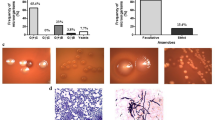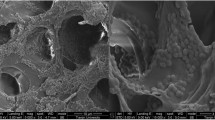Abstract
Purpose
Using a combination of metronidazole, ciprofloxacin and minocycline (3Mix) for root canal disinfection of primary teeth is a well-known technique known as the lesion sterilisation and tissue repair therapy. Minocycline has the potential to cause discoloration in treated teeth and the permanent successors. This study aimed to assess the efficacy of a new combination of antibacterial drugs, in which minocycline is replaced with clindamycin.
Methods
Thirty hopeless primary teeth according to our inclusion criteria were extracted and enrolled. The experiment was conducted in two parts: aerobic and anaerobic, and the efficacy of the two drug combinations, namely the 3Mix and the other mix (metronidazole, ciprofloxacin and clindamycin), for elimination of bacteria isolated from the primary teeth was evaluated and compared. Data were analysed using SPSS 21 via descriptive statistics and Friedman and Wilcoxon tests. Level of significance was considered at 0.05.
Results
Except for minocycline, none of the other antibiotics in the studied concentrations (25, 50 and 100 μg/mL) were able to eliminate all the bacteria. Clindamycin alone was weaker than minocycline, but its combination with metronidazole and ciprofloxacin had the same potency with no significant difference.
Conclusions
Replacement of minocycline with clindamycin in the 3Mix composition is practical and can be generalised to clinical studies and ultimately to the clinical setting.


Similar content being viewed by others
References
Akcay M, Arslan H, Yasa B, Kavrık F, Yasa E. Spectrophotometric analysis of crown discoloration induced by various antibiotic pastes used in revascularization. J Endod. 2014;40(6):845–8.
Athanassiadis B, Abbott P, Walsh LJ. The use of calcium hydroxide, antibiotics and biocides as antimicrobial medicaments in endodontics. Aust Dent J. 2007;52:64–82.
Burrus D, Barbeau L, Hodgson B. Treatment of abscessed primary molars utilizing lesion sterilization and tissue repair: literature review and report of three cases. Pediatr Dent. 2014;36(3):240–4.
Casamassimo PS, McTigue DJ, et al. Pediatric dentistry: infancy through adolescence. 5th ed. China: Linda Duncan; 2013.
Cheek CC, Heymann HO. Dental and oral discolorations associated with minocycline and other tetracycline analogs. J Esthet Restor Dent. 1999;11(1):43–8.
Chougule RB, Padmanabhan MY, Mandal MS. A comparative evaluation of root canal length measurement techniques in primary teeth. Pediatr Dent. 2012;34(3):53E–6E.
da Silva LAB, Nelson-Filho P, Faria G, de Souza-Gugelmin MCM, Ito IY. Bacterial profile in primary teeth with necrotic pulp and periapical lesions. Braz Dent J. 2006;17(2):144–8.
Finn SB. Pulpal treatment of primary teeth. Clinical pedodontics. 4th ed. Philadelphia: WB Saunders Company; 1995.
Grieve A, Friend L, Plant C. A clinical trial of three root canal medicaments. Br Dent J. 1973;134(5):188–93.
Hedayatipanah M, Torkzaban P, Zamani A, et al. Evaluation of antibody titer against Porphyromonas gingivalis in experimental periodontitis Induced by oral inoculation of Porphyromonas gingivalis in the rat model. Hamadan: Hamadan University of Medical Sciences; 2015.
Hoshino E, Kota K, Sato M, Iwaku M. Bactericidal efficacy of metronidazole against bacteria of human carious dentin in vitro. Caries Res. 1988;22(5):280–2.
Hoshino E, Iwaku M, Sato M, Ando N, Kota K. Bactericidal efficacy of metronidazole against bacteria of human carious dentin in vivo. Caries Res. 1989;23(2):78–80.
Hoshino E, Kurihara-Ando N, Sato I, et al. In-vitro antibacterial susceptibility of bacteria taken from infected root dentine to a mixture of ciprofloxacin, metronidazole and minocycline. Int Endod J. 1996;29(2):125–30.
Jaya A, Praveen P, Anantharaj A, Venkataraghavan K, Prathibha Rani S. In vivo evaluation of lesion sterilization and tissue repair in primary teeth pulp therapy using two antibiotic drug combinations. J Clin Pediatr Dent. 2012;37(2):189–91.
Johnson MS, Britto LR, Guelmann M. Impact of a biological barrier in pulpectomies of primary molars. Pediatr Dent. 2006;28(6):506–10.
Katzung B, Trevor A. ured. Basic and clinical pharmacology. 13th ed. New York: McGraw-Hill Education; 2015.
Kayalvizhi G, Subramaniyan B, Suganya G. Topical application of antibiotics in primary teeth: an overview. J Dent Child. 2013;80(2):71–9.
Kim J-H, Kim Y, Shin S-J, Park J-W, Jung I-Y. Tooth discoloration of immature permanent incisor associated with triple antibiotic therapy: a case report. J Endod. 2010;36(6):1086–91.
Kim B, Song M-J, Shin S-J, Park J-W. Prevention of tooth discoloration associated with triple antibiotics. Restor Dent Endod. 2012;37(2):119–22.
Maekawa LE, Valera MC, de Oliveira LD, et al. In vitro evaluation of the action of irrigating solutions associated with intracanal medications on Escherichia coli and its endotoxin in root canals. J Appl Oral Sci. 2011;19(2):106–12.
Manuel S, Parolia A, Kundabala M, Vikram M. Non-surgical endodontic therapy using triple-antibiotic paste. Kerala Dent J. 2010;33:88–90.
Menezes M, Valera M, Jorge A, et al. In vitro evaluation of the effectiveness of irrigants and intracanal medicaments on microorganisms within root canals. Int Endod J. 2004;37(5):311–9.
Nakornchai S, Banditsing P, Visetratana N. Clinical evaluation of 3Mix and Vitapex® as treatment options for pulpally involved primary molars. Int J Pediatr Dent. 2010;20(3):214–21.
Nanda R, Koul M, Srivastava S, Upadhyay V, Dwivedi R. Clinical evaluation of 3 Mix and Other Mix in non-instrumental endodontic treatment of necrosed primary teeth. J Oral Biol Craniofac Res. 2014;4(2):114–9.
Peters OA, Laib A, Göhring TN, Barbakow F. Changes in root canal geometry after preparation assessed by high-resolution computed tomography. J Endod. 2001;27(1):1–6.
Pinky C, Shashibhushan K, Subbareddy V. Endodontic treatment of necrosed primary teeth using two different combinations of antibacterial drugs: an in vivo study. J Indian Soc Pedod Prev Dent. 2011;29(2):121–7.
Saoud TMA, Ricucci D, Lin LM, Gaengler P. Regeneration and repair in endodontics—a special issue of the regenerative endodontics—a new era in clinical endodontics. Dent J. 2016;4(3):1–15.
Sato T, Hoshino E, Uematsu H, Noda T. In vitro antimicrobial susceptibility to combinations of drugs of bacteria from carious and endodontic lesions of human deciduous teeth. Mol Oral Microbiol. 1993a;8(3):172–6.
Sato T, Hoshino E, Uematsu H, Noda T. Predominant obligate anaerobes in necrotic pulps of human deciduous teeth. Microb Ecol Health Dis. 1993b;6(6):269–75.
Sato I, Ando-Kurihara N, Kota K, Iwaku M, Hoshino E. Sterilization of infected root-canal dentine by topical application of a mixture of ciprofloxacin, metronidazole and minocycline in situ. Int Endod J. 1996;29(2):118–24.
Sjögren U, Figdor D, Persson S, Sundqvist G. Influence of infection at the time of root filling on the outcome of endodontic treatment of teeth with apical periodontitis. Int Endod J. 1997;30(5):297–306.
Sundqvist G, Figdor D, Persson S, Sjögren U. Microbiologic analysis of teeth with failed endodontic treatment and the outcome of conservative re-treatment. Oral Surg Oral Med Oral Pathol Oral Radiol Endod. 1998;85(1):86–93.
Takushige T, Cruz E, Asgor Moral A, Hoshino E. Endodontic treatment of primary teeth using a combination of antibacterial drugs. Int Endod J. 2004;37(2):132–8.
Thomson A, Kahler B. Regenerative endodontics–biologically-based treatment for immature permanent teeth: a case report and review of the literature. Aust Dent J. 2010;55(4):446–52.
Torabinejad M, Fouad A, Walton RE. Endodontics: principles and practice. 5th ed. Amsterdam: Elsevier Health Sciences; 2015.
Trairatvorakul C, Detsomboonrat P. Success rates of a mixture of ciprofloxacin, metronidazole, and minocycline antibiotics used in the non-instrumentation endodontic treatment of mandibular primary molars with carious pulpal involvement. Int J Pediatr Dent. 2012;22(3):217–27.
Valera MC, Da Rosa JA, Maekawa LE, et al. Action of propolis and medications against Escherichia coli and endotoxin in root canals. Oral Surg Oral Med Oral Pathol Oral Radiol. 2010;110(4):e70–4.
Velasco-Loera N, De Alba-Vazquez Y, Garrocho-Rangel A, et al. Comparison of the antibacterial effect of modified 3-mix paste versus Ultrapex over anaerobic microorganisms from infected root canals of primary teeth: an in vitro study. J Clin Pediatr Dent. 2012;36(3):239–44.
Acknowledgements
Funding was provided by Hamadan University of Medical Sciences.
Author information
Authors and Affiliations
Corresponding author
Ethics declarations
Conflict of interest
The authors declare no conflict of interest.
Ethical approval
Ethical approval was obtained from the research ethics committees at the Hamadan University of Medical Sciences and in accordance with the ethical standards of the institutional and/or national research committee and with the 1964 Helsinki Declaration and its later amendments or comparable ethical standards.
Additional information
Publisher's Note
Springer Nature remains neutral with regard to jurisdictional claims in published maps and institutional affiliations.
Rights and permissions
About this article
Cite this article
Rafatjou, R., Yousefimashouf, R., Farhadian, M. et al. Evaluation of the antimicrobial efficacy of two combinations of drugs on bacteria taken from infected primary teeth (in vitro). Eur Arch Paediatr Dent 20, 609–615 (2019). https://doi.org/10.1007/s40368-019-00446-4
Received:
Accepted:
Published:
Issue Date:
DOI: https://doi.org/10.1007/s40368-019-00446-4




